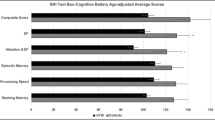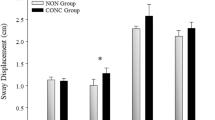Abstract
Mild traumatic brain injury (mTBI) causes deficits in motor and cognitive function. There is a dearth of research examining the association between these deficits. The purpose of this investigation was to examine the effect of mTBI on the association between cognitive and motor function. Thirty-six individuals completed a neurocognitive test battery and postural control assessment at baseline and were retested 24-h post mTBI. Reaction time and accuracy to various cognitive tasks was assessed. Postural control was indexed with the somatosenory organization test. This test allows for the decomposition of postural control resulting from the integration of visual, somatosensory and vestibular information. The association between cognitive and motor function was assessed with correlational analyses. Overall, it was found that mTBI resulted in increased simple and choice reaction time as well as deficits in verbal and visual memory. mTBI was also found to reduce overall postural control, especially when visual information was utilized. Prior to injury there was no association between cognitive and motor function—indicating minimal association between cognitive and motor function. After injury there were significant positive correlations between cognitive and motor function. The findings suggest that transient neural insults resulting from mTBI lead to increased cognitive-motor association. It is speculated that a shared neural process, such as visuospatial attention is damaged resulting in similar deficits in cognitive and motor function.


Similar content being viewed by others
References
American Academy of Neurology, Practice Parameter: the management of concussion in sports (summary statement) (1997) Report of the quality standards subcommittee of the American Academy of Neurology. Neurology 48:581–585
Aubry M, Cantu R, Dvorak J, Graf-Baumann T, Johnston K, Kelly J, Lovell M, McCrory P, Meeuwisse W, Schamasch P (2002) Summary and agreement statement of the first international conference on concussion in sport, Vienna 2001. Br J Sports Med 36:6–7
Bowen A, Wenman R, Mickelborough J, Foster J, Hill E, Tallis R (2001) Dual-task effects of talking while walking on velocity and balance following a stroke. Age Ageing 30:319–323
Broglio SP, Puetz TW (2008) The effect of sport concussion on neurocognitive function,self-report symptoms, and postural control: sa meta-analysis. Sports Med 38:53–67
Broglio SP, Macciocchi SN, Ferrara MS (2007a) Neurocognitive performance of concussed athletes when symptom free. J Athl Train 42:502–508
Broglio SP, Macciocchi SN, Ferrara MS (2007b) Sensitivity of the concussion assessment battery. Neurosurgery 60:1050–1057
Catena RD, van Donkelaar P, Chou LS (2007a) Altered balance control following concussion is better detected with an attention test during gait. Gait Posture 25:406–411
Catena RD, van Donkelaar P, Chou LS (2007b) Cognitive task effects on gait stability following concussion. Exp Brain Res 176:23–31
Cavanaugh JT, Guskiewicz KM, Giuliani C, Marshall S, Mercer V, Stergiou N (2005) Detecting altered postural control after cerebral concussion in athletes with normal postural stability. Br J Sports Med 39:805–11
Collie A, Maruff P, McStephen M, Darby DG (2003) Psychometric issues associated with computerised neuropsychological assessment of concussed athletes. Br J Sports Med 37:556–559
Collins MW, Grindel SH, Lovell MR, Dede DE, Moser DJ, Phalin BR, Nogle S, Wasik M, Cordry D, Daugherty KM, Sears SF, Nicolette G, Indelicato P, McKeag DB (1999) Relationship between concussion and neuropsychological performance in college football Players. JAMA 282:964–970
Collins MW, Iverson GL, Lovell MR, McKeag DB, Norwig J, Maroon JC (2003) On-field predictors of neuropsychological and symptom deficit following sports-related concussion. Clin J Sport Med 13:222–229
Drew AS, Langan J, Halterman C, Osternig LR, Chou LS, van Donkelaar P (2007) Attentional disengagement dysfunction following mTBI assessed with the gap saccade task. Neurosci Lett 417:61–65
Erlanger DM (2002) HeadMinder concussion resolution index (CRI)—Professional manual, 1st edn
Erlanger DM, Feldman D, Kutner KC, Kroger H, Festa J, Barth J, Freeman J, Broshek DK (2003) Development and validation of a web-based neuropsychological test protocolfor sports-related return-to-play decision-making. Arch Clin Neuropsychol 18:293–316
Finkelstein EA, Corso PS, Miller TR (2006) The incidence and economic burden of injuries in the United States. Oxford University Press, New York
Giza CC, Hovda DA (2001) The neurometabolic cascade of concussion. J Athl Train 36:228–235
Guskiewicz KM, Bruce SL, Cantu RC, Ferrara MS, Kelly JP, McCrea M, Putukian M, McLeod TC; NATIONAL ATHLETIC TRAINERS ASSOCIATION (2004) Recommendations on management of sport-related concussion: summary of the National Athletic Trainers' Association position statement. Neurosurgery 55:891–896
Guskiewicz KM, Ross SE, Marshall SW (2001) Postural stability and neuropsychological deficits after concussion in collegiate athletes. J Athl Train 36:263–273
Guskiewicz KM, McCrea M, Marshall SW, Cantu RC, Randolph C, Barr W, Onate JA, Kelly JP (2003) Cumulative effects associated with recurrent concussion in collegiate football players: the NCAA concussion study. JAMA 290:2549–2555
Halterman CI, Langan J, Drew A, Rodriguez E, Osternig LR, Chou LS, van Donkelaar P (2006) Tracking the recovery of visuospatial attention deficits in mild traumatic brain injury. Brain 129:747–753
Hausdorff JM, Doniger GM, Springer S, Yogev G, Simon ES, Giladi N (2006) A common cognitive profile in elderly fallers and in patients with Parkinson’s disease: the prominence of impaired executive function and attention. Exp Aging Res 32:411–429
Holtzer R, Verghese J, Xue X, Lipton RB (2006) Cognitive processes related to gait velocity: results from the Einstein aging study. Neuropsychology 20:215–223
Holtzer R, Friedman R, Lipton RB, Katz M, Xue X, Verghese J (2007) The relationship between specific cognitive functions and falls in aging. Neuropsychology 21:540–548
Kahneman D (1973) Attention and effort. Prentice-Hall, Eaglewood-Cliffs
Kerr B, Condon SM, McDonald LA (1985) Cognitive spatial processing and the regulation of posture. J Exp Psychol Hum Percept Perform 11:617–622
Konczak J, Timmann D (2007) The effect of damage to the cerebellum on sensorimotor and cognitive function in children and adolescents. Neurosci Biobehav Rev 31:1101–1113
Langlois JA, Rutland-Brown W, Wald MM (2006) The epidemiology and impact of traumatic brain injury: a brief overview. J Head Trauma Rehabil 21:375–8
Li S-C, Aggen SH, Nesselroade JR, Baltes PB (2001) Short-term fluctuations in elderly people’s sensorimotor functioning predict text and spatial memory performance: the MacArthur successful aging studies. Gerontology 47:100–116
Lovell MR (2005) ImPACT 2005 (4.0) Clinical interpretation manual. http://www.impacttest.com/tf.htm
Maylor EA, Wing AM (1996) Age differences in postural stability are increased by additional cognitive demands. J Gerontol B Psychol Sci Soc Sci 51:P143–154
McCrea M, Guskiewicz KM, Marshall SW, Barr W, Randolph C, Cantu RC, Onate JA, Yang J, Kelly JP (2003) Acute effects and recovery time following concussion in collegiate football players: the NCAA concussion study. JAMA 290:2556–2563
Nashner LM (1997) Computerized dynamic posturography. In: Jacobson GP, Newman CW, Kartuch JM (eds) Handbook of balance function testing. Mosby Year Book, St Louis, pp 280–305
Nesselroade JR, Salthouse TA (2004) Methodological and theoretical implications of intraindividual variability in perceptual-motor performance. J Gerontol B Psychol Sci Soc Sci 59:49–55
Pellman EJ, Viano DC, Tucker AM, Casson IR (2003a) Concussion in professional football: location and direction of helmet impacts-Part 2. Neurosurgery 53:1328–1340
Pellman EJ, Viano DC, Tucker AM, Casson IR, Waeckerle JF (2003b) Concussion in professional football: reconstruction of game impacts and injuries. Neurosurgery 35:799–814
Piland SG, Motl RW, Ferrara MS, Peterson CL (2003) Evidence for the factorial and construct validity of a self-report concussion symptoms scale. J Athl Train 38:104–112
Piland SG, Motl RW, Guskiewicz KM, McCrea M, Ferrara MS (2006) Structural validity of a self-report concussion-related symptom scale. Med Sci Sports Exerc 38:27–32
Pugh KA, Lipsitz LA (2002) The microvascular frontal-subcortical syndrome of aging. Neurobiol Aging 23:421–431
Rosenbaum DA (2005) The Cinderella of psychology: the neglect of motor control in the science of mental life and behavior. Am Psych 60:308–317
Serrien DJ, Ivry RB, Swinnen SP (2007) The missing link between action and cognition. Prog Neurobiol 82:95–107
Slobounov S, Sebastianelli W, Simon R (2002) Neurophysiological and behavioral concomitants of mild brain injury in collegiate athletes. Clin Neurophysiol 113:185–193
Slobounov S, Tutwiler R, Sebastianelli W, Slobounov E (2006) Alteration of postural responses to visual field motion in mild traumatic brain injury. Neurosurgery 59:134–139
Slobounov S, Slobounov E, Sebastianelli W, Cao C, Newell K (2007) Differential rate of recovery in athletes after first and second concussion episodes. Neurosurgery 61:338–344
Sosin DM, Sniezek JE, Thurman DJ (1994) Incidence of mild and moderate brain injury in the United States. Brain Inj 10:47–54
Sosnoff JJ, Broglio S, Hillman CH, Ferrara M (2007) Concussion does not impact intra-individual response time variability. Neuropsychology 21:796–802
Thurman DJ, Alverson C, Browne D (1999) Traumatic brain injury in the United States: a report to congress. Centers for Disease Control and Prevention, Atlanta
van Donkelaar P, Osternig L, Chou LS (2006) Attentional and biomechanical deficits interact after mild traumatic brain injury. Exerc Sport Sci Rev 34:77–82
Woollacott M, Shumway-Cooke A (2002) Attention and the control of posture and gait: a review of an emerging area of research. Gait Posture 16:1–14
Author information
Authors and Affiliations
Corresponding author
Rights and permissions
About this article
Cite this article
Sosnoff, J.J., Broglio, S.P. & Ferrara, M.S. Cognitive and motor function are associated following mild traumatic brain injury. Exp Brain Res 187, 563–571 (2008). https://doi.org/10.1007/s00221-008-1324-x
Received:
Accepted:
Published:
Issue Date:
DOI: https://doi.org/10.1007/s00221-008-1324-x




